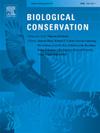Threats and conservation status of the endemic terrestrial arthropods of the Azores
IF 4.4
1区 环境科学与生态学
Q1 BIODIVERSITY CONSERVATION
引用次数: 0
Abstract
Insular ecosystems are disproportionately threatened by human activities, leading to an unprecedented decline in species diversity, particularly on remote archipelagos like the Azores. However, the impacts of humans on arthropods, which typically represent a big proportion of island biotas, remain poorly documented. We present an assessment of threats affecting different groups of species, examining the relationship between species occupancy, IUCN threat categories and trophic interactions for arthropods in the Azores (Macaronesia). We compiled data on endemic arthropods from published lists and IUCN assessments, including extinction risk, direct threats, and geographical ranges, to identify key pressures on species. Using network analyses, we examined the association between extinction risk and number of species, also estimating the IUCN Red List Index (RLI) for each island conservation status. We found that some of the Azorean endemic arthropod species have already gone extinct and more than half are classified as threatened by the IUCN Red List. Of these, predatory beetles (Coleoptera) and spiders (Araneae) have the highest numbers of threatened species, mainly due to habitat degradation, the spread of invasive plant species, and climate change. The RLI differs greatly among islands, being the lowest in Santa Maria, which concentrates a large number of critically endangered (CR) single-island endemic species, and higher in islands with larger and better-preserved native forest fragments, such as Terceira. A comprehensive approach integrating habitat protection, invasive species management and conservation measures is essential to ensure the long-term survival of Azorean arthropod endemic species in particular and island biota in general.
亚速尔群岛特有陆生节肢动物的威胁与保护现状
岛屿生态系统不成比例地受到人类活动的威胁,导致物种多样性空前减少,特别是在亚速尔群岛等偏远群岛。然而,人类对节肢动物的影响(节肢动物通常占岛屿生物的很大一部分)仍然缺乏文献记录。本文对亚速尔群岛(Macaronesia)节肢动物的物种占用、IUCN威胁类别和营养相互作用之间的关系进行了评估。我们从已公布的名录和IUCN评估中收集了地方性节肢动物的数据,包括灭绝风险、直接威胁和地理范围,以确定物种面临的主要压力。通过网络分析,我们研究了灭绝风险与物种数量之间的关系,并估计了每个岛屿保护状态的IUCN红色名录指数(RLI)。我们发现一些亚速尔特有的节肢动物物种已经灭绝,超过一半的物种被IUCN列为濒危物种红色名录。其中,掠食性甲虫(鞘翅目)和蜘蛛(蜘蛛目)的濒危物种数量最多,这主要是由于栖息地退化、入侵植物物种的传播和气候变化。不同岛屿的RLI差异很大,圣玛丽亚岛的RLI最低,那里集中了大量的严重濒危(CR)单岛特有物种,而在拥有较大和保存较好的原生森林碎片的岛屿,如特塞拉岛,RLI较高。综合生境保护、入侵物种管理和保护措施的综合方法对于确保亚速尔节肢动物特有物种特别是岛屿生物群的长期生存至关重要。
本文章由计算机程序翻译,如有差异,请以英文原文为准。
求助全文
约1分钟内获得全文
求助全文
来源期刊

Biological Conservation
环境科学-环境科学
CiteScore
10.20
自引率
3.40%
发文量
295
审稿时长
61 days
期刊介绍:
Biological Conservation is an international leading journal in the discipline of conservation biology. The journal publishes articles spanning a diverse range of fields that contribute to the biological, sociological, and economic dimensions of conservation and natural resource management. The primary aim of Biological Conservation is the publication of high-quality papers that advance the science and practice of conservation, or which demonstrate the application of conservation principles for natural resource management and policy. Therefore it will be of interest to a broad international readership.
 求助内容:
求助内容: 应助结果提醒方式:
应助结果提醒方式:


